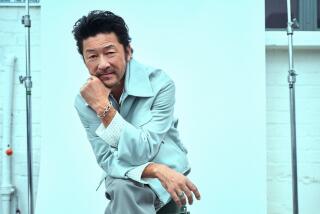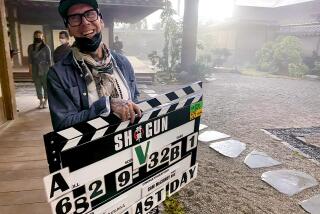Cruise’s ‘Samurai’: a battle of opinions
- Share via
Mark Ravina calls it “Dances With Samurai.”
More than a decade after Kevin Costner’s Oscar-winning film about the American West, historical epics remain a difficult creative and commercial balancing act for Hollywood, particularly when the subject matter is freighted with varying ethnic, national or cultural interpretations.
For the record:
12:00 a.m. Dec. 11, 2003 For The Record
Los Angeles Times Thursday December 11, 2003 Home Edition Main News Part A Page 2 National Desk 1 inches; 39 words Type of Material: Correction
“Samurai” actress -- An article in Wednesday’s Calendar incorrectly referred to a Japanese actress in “The Last Samurai” as Hiroyuki Sanada Koyuki. The actress goes by a single name, Koyuki. Another actor in the film is named Hiroyuki Sanada.
“The Last Samurai,” which opened last weekend, is only the newest example. In it, a dashing protagonist, dressed in full samurai battle gear, wields a long sword as he charges toward an unseen enemy to defend the ancient tradition of Japan. The fact that the star is a white American actor -- Tom Cruise -- is a double-edged sword.
In Japan, the film has been warmly received by fans, government officials and scholars grateful for the celebrity wattage sympathetically illuminating the country’s past.
In the U.S., however, Ravina and some other scholars and activists say they are disappointed that a cinematic portrayal more in the mode of “Shogun” than “Crouching Tiger, Hidden Dragon” is still in play.
“I am just surprised that we are still doing it that way now. The fact that you need to make it so much about Tom Cruise to find out about Japan is a little bit disappointing,” said Ravina, author of “The Last Samurai: The Life and Battles of Saigo Takamori,” the man many consider to be Japan’s real last samurai.
“It is disturbing because we are striving to be a multicultural society,” said Ravina, whose book was not a source for the movie. “That requires that we appreciate each other’s cultures and that we will go see a movie even if the star is a person who doesn’t look like us.”
As played by Cruise, Nathan Algren is an embittered Civil War veteran who travels to Japan as a mercenary and is ultimately transformed by the people who were initially his enemy -- a rebel band of samurai warriors. The movie’s authors, director Edward Zwick and his co-writers John Logan and Marshall Herskovitz, say they went to great pains to portray Japanese culture and bushido -- the way of the samurai -- in a sympathetic light.
A year before its release, they began marketing the movie in Japan, where Cruise -- the country’s most popular non-Japanese movie star -- made filming of “The Last Samurai” a national media event. In August, Cruise, Zwick and the Japanese cast made a special appearance in Tokyo’s Roppongi Hills cinema complex, where 7,000 people showed up to watch four scenes from the movie -- the first public glimpse of the film. The invitation to that event was so coveted that nightly news anchors displayed it on their newscasts. In Kyoto the vice mayor showed up at the November premiere at the historic Nijo Castle.
The filmmakers’ efforts seem to have paid off in Japan. The film, which was simultaneously released there and in North America this past weekend, grossed $8.4 million in Japan on 540 screens -- 150% higher than Cruise’s “Vanilla Sky” and 17% higher than his last film, “Minority Report.” In Japan “Samurai” attracted a broad demographic, including young males and females as well as moviegoers over 40.
“It was very moving to see Tom Cruise [as Algren] gradually fitting in with the group of samurai and learning diligence,” said Tomotsugu Mizukami, spokesman of the Tourism Promotion Section at Kyoto City government. “It is such a good chance for Japanese people to rediscover what the Japanese culture/samurai spirit really is. I think it’s a great and right way of exporting Japanese culture.”
In the United States, however, the box office report was less than spectacular. Although bad weather in the East no doubt contributed to a weak box office overall, the movie grossed less than other recent Cruise pictures -- only $24.3 million -- and failed to grab a large share of younger moviegoers.
Clearly, Hollywood’s major studios have long viewed Cruise as a safe bet -- particularly in a movie like “Samurai,” with a budget of $140 million and millions more spent on marketing.
But they may be shortchanging an increasingly sophisticated American moviegoing audience by continuing to tell stories about other cultures through the eyes of white, disillusioned heroes, said Jennifer Kuo, president of the nonprofit watchdog group Media Action Network for Asian Americans. “I wouldn’t protest the movie but it does perpetuate the stereotypes in American cinema -- it’s through the perspective of a white man,” said Kuo. Zwick, however, noted that the Japanese seem to have no problem with a big star going to their country and making a movie that “honors their culture.”
From Ravina’s perspective, the film goes too far in the liberties it takes with history. “What gets left out of that is that the samurai were a hereditary elite,” said Ravina. “They were ruthless warriors. They are not a particularly heroic class ....This film wants to say it’s giving us a sense of Japan, but it’s giving us a sense of Japan only in a way the Japanese romanticize their own past.”
Indeed, in Japan “The Last Samurai’s” theme of a lost Westerner finding his soul through the country’s ancient culture stirs up feelings of nostalgia and pride. The film’s exaltation of the ancient samurai class as well as its depiction of Japanese women as humble and demure is welcomed by many in a country that is undergoing a deep search for its national identity. Even if the film is not historically accurate, it speaks to other pressing matters in modern day Japan, said Haruo Mizuno, a movie director and one of Japan’s most noted film critics.
“The important things, like the fellowship, ties to other people, or the understanding of ... things different from one’s own culture, we should be able to learn such an essence from the film,” he said. “Also, the woman played by [Hiroyuki Sanada] Koyuki shows something that Japanese women forget about. There must be some sense of modesty and gracefulness that Japanese women can learn.” For whatever reason, Japanese experts say, it often takes Western validation of things Japanese for the people themselves to acknowledge and embrace them -- and Cruise’s transformation into a samurai represents the highest form of validation.
“When I watched ‘The Last Samurai,’ I recalled the director Zwick’s ‘Glory,’ ” continued Mizuno, referring to the 1989 film where a Civil War colonel played by Matthew Broderick learns about the humanity and courage of blacks through the soldiers under his command. “After he was taken prisoner [in ‘The Last Samurai’], he gradually learns the language and starts reaching out to the samurai. I consider that a theme that Japanese people feel very attracted to.”
While in Japan many seem willing to overlook historical inaccuracies, in America some noted Japan scholars loathe the misperceptions the film may have caused among those unfamiliar with Japanese history. “There was so much wrong with the film historically that it is hard to know where to start,” said Dani Botsman, an associate professor of 19th century Japanese history at Harvard, who was invited to see a special screening of the film in late November with Zwick, a Harvard alum.
“Next semester I am teaching a class on this very period and I am already dreading the debunking I am going to have to do.”
While the samurai warriors in the film use only spears, swords and knives in battle, Botsman said they were actually using guns by then. “What you have in this film is an American cowboy type showing the emperor the way -- it’s [World War II General Douglas] MacArthur coming to the rescue of [Emperor] Hirohito,” he said, alluding to a final scene in the film where Cruise’s character reminds the emperor not to lose his Japanese identity.
The film is part of a long tradition in which Western composers, writers and filmmakers portray Asia as exotic and inscrutable, said Fred Notehelfer, director of the UCLA Center for Japanese Studies and professor of Japanese history.
“Why are we going through this again?” asked Notehelfer, who declined an offer by the filmmakers to sit on the set as an advisor. “We have turned the tables and said we can reenter this exotic world by doing something even more exotic, which is to turn this American into a samurai.”
Notehelfer said the notion of a Westerner in 19th century Japan joining the samurai “is patently absurd.... In any case, this is a wild tale, and wild tales have a dynamic of their own which cannot easily be reined in through the use of reason.”
But director Zwick says movies are intended to be tales of fiction. “It is myth and the idealization of things that is the stuff of movies,” said Zwick, who last week was voted best director by the National Board of Review, a group composed of film scholars, students and critics. “It is as important to celebrate what is poetic and idealized as it is to celebrate a reality. We are as inspired by myth as we are by history.”
But myths can lead to stereotypes, some say.
“Basically, [the samurai rebellion] was a revolt by a die-hard bunch of conservatives and this movie makes a tragedy of it,” said Toshio George Tsukahira, a consultant on the film who served in Japan for the U.S. foreign service from the 1960s to 1975. But, he added, Hollywood filmmaking should be taken with a grain of salt. “I don’t see why people get morally indignant about it,” said Tsukahira, noting that he enjoyed the film.
In addition to the exaltation of the samurai, Asian American groups were irritated by a casting call made by Warner Bros.’ special events department seeking “Beautiful Asian women” to “mingle in character” for the premiere’s after party.
“They were calling around Little Tokyo to see if they could find someone who would dress as a geisha,” said Chris Komai, spokesman for the Japanese American Museum. “The thinking is pretty shallow but it’s not a surprise.”
In any case, Zwick admits that his interest was piqued by the theme of having two cultures meet: Western explorers hitting the shores of an insular Japan in the late 19th century. “Do I have a bias that is born of being an American filmmaker and how that resonates with other cultures? Yes,” he said. “The fact that I approached this story from that angle reveals this bias. But I also think that this movie, if it succeeds or fails, honors the richness and complexity and beauty of this other culture.”
Times staff writer Teresa Watanabe contributed to this report from Los Angeles and special correspondent Rie Sasaki contributed from Japan.
More to Read
Only good movies
Get the Indie Focus newsletter, Mark Olsen's weekly guide to the world of cinema.
You may occasionally receive promotional content from the Los Angeles Times.










